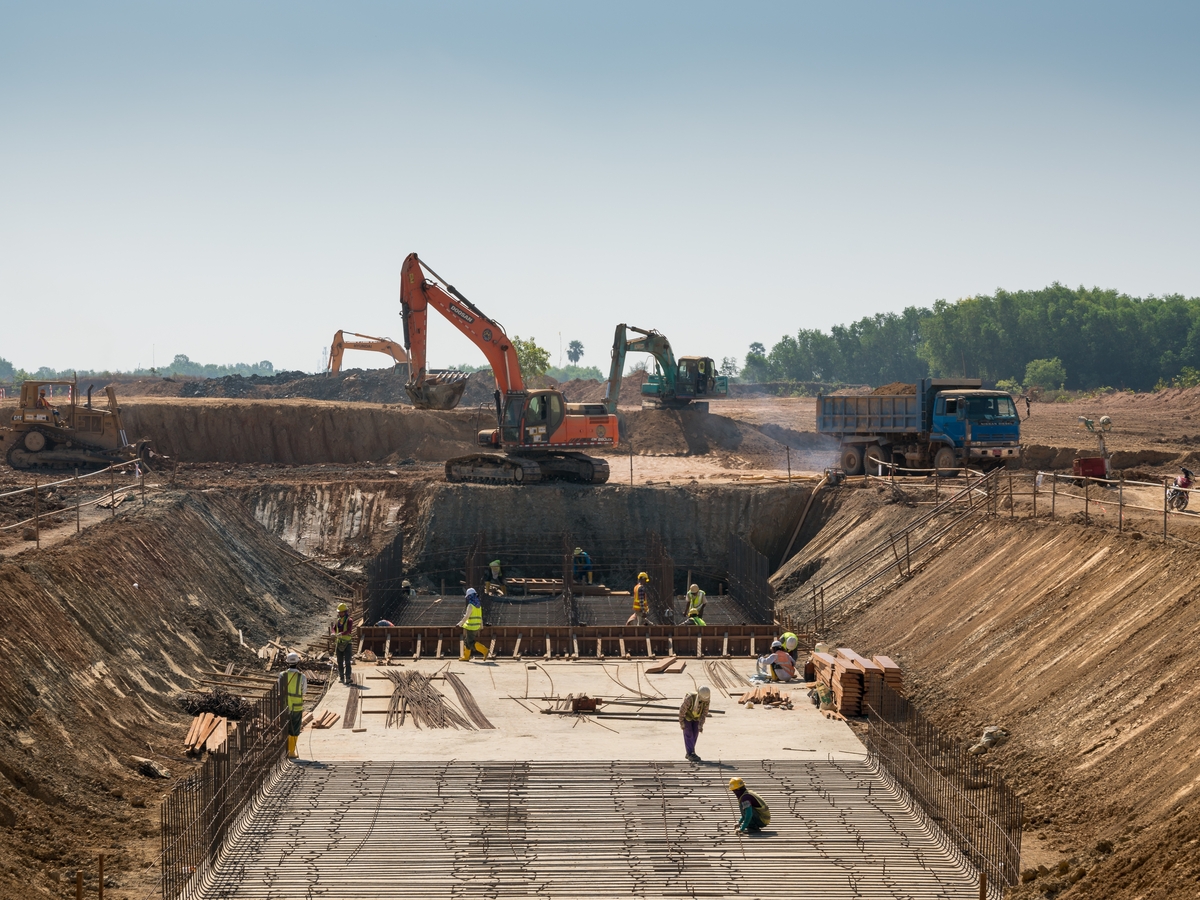The construction industry, a cornerstone of global infrastructure development, faces perennial challenges that impact project efficacy and success. Statistics underscore the prevalence and implications of common construction mistakes, highlighting the pressing need for proactive solutions and meticulous management.
Studies reveal that nearly 98% of construction megaprojects experience cost overruns or delays, contributing to a staggering $1.6 trillion annually in global losses. These setbacks often stem from a nexus of errors ingrained in project execution, ranging from insufficient planning to technology integration challenges. The impact is profound, with schedule delays averaging 20 months and budget overruns approaching 80% of the initial estimate in major projects.
These missteps reverberate throughout the construction ecosystem, from misinterpretations of design specifications causing rework to inadequate risk management leading to legal disputes. Inadequate communication and collaboration among stakeholders also emerge as key culprits, resulting in operational inefficiencies and delayed progress.
Moreover, technological implementation challenges compound these issues, as construction-specific technologies are underutilized, leading to inefficiencies in data utilization and missed opportunities for enhancing project outcomes.
This article dives deep into the eleven most common construction mistakes observed in 2024, dissecting their impact, and root causes, and proposing robust strategies to rectify and prevent them. By unpacking these challenges and offering actionable solutions, the aim is to arm construction professionals with insights and tools necessary to navigate these complexities, fostering a paradigm shift towards more efficient, resilient, and successful construction practices.
Table of Contents
Construction Mistakes 1: Lack of Detailed Planning
Summary
- Absence of Comprehensive Planning:
- Lack of detailed blueprints and timelines.
- Inadequate assessment of project scope and requirements.
Explanation
The absence of detailed planning stands as foundational construction mistakes. It encompasses various facets, including the failure to create comprehensive blueprints and timelines that chart the course of the project from inception to completion. Insufficient assessment of project scope and requirements amplifies this issue, leading to ambiguity in project goals and deliverables.
In practical terms, these construction mistakes manifest as a lack of clearly defined objectives, causing confusion among stakeholders regarding their roles and responsibilities. It often results in timelines being riddled with uncertainties, making it challenging to adhere to schedules and milestones. Moreover, without a robust plan in place, there’s a higher likelihood of encountering unexpected obstacles, leading to costly delays and revisions.
Impact
- Budget Overruns and Schedule Delays:
- Unclear project scope leads to frequent changes and cost escalations.
- Inability to meet deadlines due to ambiguous planning.
The repercussions of inadequate planning reverberate throughout the project lifecycle. Budget overruns become commonplace due to frequent alterations stemming from an ill-defined project scope. Such changes, coupled with a lack of foresight, contribute to cost escalations, undermining financial projections. Simultaneously, the absence of a well-structured plan hampers the project’s ability to meet deadlines, resulting in schedule delays that disrupt the entire construction timeline.
Solutions and Prevention Strategies
- Thorough Project Assessment:
- Conduct comprehensive evaluations to determine project scope.
- Engage stakeholders for detailed requirement analysis.
To rectify this mistake, a comprehensive approach is essential. Thorough project assessments must be conducted, involving all stakeholders, to ascertain and document the project scope meticulously. This should encompass a detailed requirement analysis, ensuring that all aspects of the project are considered and incorporated into the plan. Establishing a robust planning phase lays the groundwork for a more structured and predictable project execution and avoids construction mistakes.
Suggested article to read: Construction Planning; Everything You Need to Know in 2024

Construction Mistakes 2: Poor Budgeting and Cost Management
Summary
- Inaccurate Budget Projections:
- Lack of detailed cost estimation for materials, labor, and contingencies.
- Failure to account for unforeseen expenses.
Explanation
Poor budgeting and cost management plague construction projects when there’s an absence of precise cost estimations is another construction mistakes. This encompasses a failure to conduct meticulous assessments of material costs, labor expenses, and appropriate contingency allocations. Often, the budget projections lack depth and fail to account for potential unforeseen expenses or market fluctuations, leading to significant disparities between projected and actual costs.
The repercussions of inadequate budgeting are pervasive in construction mistakes. It leads to financial strains and compromises project progress due to a lack of adequate funds allocated to various phases. Unforeseen expenses often arise, causing budget overruns that can escalate rapidly, impacting the overall financial health of the project and the stakeholders involved.
Impact
- Financial Instability and Project Disruptions:
- Budget shortfalls disrupt project phases and compromise quality.
- Inability to procure necessary materials or resources due to financial constraints.
The impact extends beyond mere financial constraints. Budget shortfalls disrupt the seamless flow of project phases, compromising timelines and overall project quality. Furthermore, when funds fall short, it hampers the ability to procure necessary materials or resources, leading to project delays and potential rework as construction mistakes.
Solutions and Prevention Strategies
- Thorough Cost Estimation:
- Conduct comprehensive assessments of material, labor, and overhead costs.
- Incorporate adequate contingency reserves into the budget.
To mitigate this construction mistakes, meticulous cost estimation becomes pivotal. Detailed assessments of material costs, labor expenditures, and overheads are essential for creating accurate budget projections. Additionally, integrating adequate contingency reserves to accommodate unforeseen expenses or market fluctuations ensures a more resilient budget framework. Regular review and adjustment of budgets as the project progresses are crucial to maintain financial stability and project continuity.
Suggested article to read: Tips for Effective Construction Budget Management; Guide to 2024
Construction Mistakes 3: Inadequate Risk Management
Summary
- Lack of Comprehensive Risk Assessment:
- Failure to identify and analyze potential project risks.
- Absence of contingency plans for probable setbacks.
Explanation
Inadequate risk management in construction projects stems from a failure to conduct thorough risk assessments. It involves the oversight of potential risks, ranging from site-specific challenges to external factors like regulatory changes or market fluctuations. Without a comprehensive understanding of these risks, projects lack contingency plans to address or mitigate potential setbacks, leaving them vulnerable to unexpected obstacles.
These construction mistakes are reflected in the project’s vulnerability to disruptions. Unforeseen events or issues that could have been anticipated with proper risk management may result in costly delays, rework, or even project abandonment. Moreover, overlooking risk factors might lead to compromised project quality or safety, impacting the project’s reputation and stakeholder confidence.
Impact
- Project Vulnerability and Uncertainty:
- Increased likelihood of delays, cost overruns, and quality issues.
- Diminished stakeholder confidence and potential legal disputes.
The ramifications of inadequate risk management are significant. Projects become susceptible to uncertainties, with an increased likelihood of delays, budget overruns, or compromised quality. Stakeholder confidence wanes, leading to potential disputes or loss of future business opportunities due to a tarnished reputation.
Solutions and Prevention Strategies
- Comprehensive Risk Assessment:
- Identify potential risks across all project phases.
- Develop proactive contingency plans for probable setbacks.
To address this mistake, a proactive approach to risk management is imperative. Conducting comprehensive risk assessments across all project phases, including site-specific and external risks, is crucial. This should be followed by the development of proactive contingency plans that outline responses to identified risks. Regular reassessment and updating of risk management strategies throughout the project lifecycle are vital to navigating unforeseen challenges effectively.
Suggested article to read: 10 Types of Risk Management Strategies in 2024
Construction Mistakes 4: Subpar Quality Control and Assurance
Summary
- Inadequate Quality Checks:
- Lack of robust quality control measures throughout project phases.
- Failure to adhere to regulatory and quality standards.
Explanation
Subpar quality control and assurance signify a lack of stringent checks and balances within construction projects. This oversight encompasses the absence of rigorous quality control measures at every stage of the project. Additionally, it involves disregarding regulatory and industry quality standards, leading to compromised workmanship or material integrity.
These construction mistakes materialize in various ways, leading to potential defects, rework, or safety hazards. Without comprehensive quality control measures, errors may propagate across the project, impacting its structural integrity or functional aspects. Moreover, deviating from established quality standards heightens the risk of non-compliance, potentially resulting in legal ramifications or project delays for corrective actions.
Impact
- Risk of Defects and Non-Compliance:
- Potential safety hazards or structural defects due to poor quality.
- Legal repercussions and project delays for non-compliance with regulations.
The repercussions of subpar quality control are profound. Projects become susceptible to structural defects or safety hazards, compromising the project’s longevity and functionality. Non-compliance with regulatory standards not only poses legal risks but also leads to potential delays as corrective actions must be undertaken.
Solutions and Prevention Strategies
- Robust Quality Control Measures:
- Implement stringent quality checks at every project stage.
- Adhere to industry standards and regulations without compromise.
To rectify these construction mistakes, a focus on robust quality control measures is essential. Implementing stringent checks at each project phase ensures adherence to quality standards and regulatory requirements. Emphasizing the importance of quality among all stakeholders and fostering a culture of excellence can significantly mitigate the risks associated with subpar quality control. Regular audits and inspections serve as proactive measures to identify and rectify any quality issues promptly.
Suggested article to read: Construction Quality Management; Ultimate Guide 2024

Construction Mistakes 5: Insufficient Communication and Collaboration
Summary
- Lack of Transparent Communication Channels:
- Absence of effective communication methods among stakeholders.
- Inadequate collaboration leads to misunderstanding and delays.
Explanation
Insufficient communication and collaboration denote a deficiency in establishing clear and open channels among project stakeholders. This includes a lack of effective methods for sharing information, inadequate platforms for collaboration, and a failure to foster an environment conducive to open dialogue.
These construction mistakes surface as a barrier to effective project management. Misunderstandings among team members, delayed responses, or conflicting instructions often arise due to poor communication. Additionally, inadequate collaboration may lead to missed deadlines, rework, or design discrepancies, impacting project efficiency and outcomes.
Impact
- Operational Inefficiencies and Delayed Progress:
- Misunderstandings lead to errors and project setbacks.
- Delays in decision-making and execution due to communication gaps.
The impact of insufficient communication and collaboration manifests as operational inefficiencies and delayed progress. Misinterpretations or delayed communications contribute to errors, leading to setbacks in project timelines. Moreover, communication gaps hinder swift decision-making, impeding the project’s overall execution.
Solutions and Prevention Strategies
- Establish Clear Communication Protocols:
- Define and implement transparent communication channels.
- Foster a culture of open dialogue and collaboration among stakeholders.
Addressing these construction mistakes require the establishment of clear communication protocols. Defining transparent channels for information exchange and decision-making is crucial. Additionally, fostering a culture that values open dialogue and collaborative problem-solving ensures that all stakeholders are aligned and can contribute effectively to project success. Regular meetings, concise documentation, and utilizing modern communication tools aid in enhancing collaboration and minimizing communication barriers.
Suggested article to read: How to Improve Construction Productivity? Guide to 2024
Construction Mistakes 6: Mismanagement of Resources
Summary
- Inefficient Resource Allocation:
- Failure to optimize manpower, materials, and equipment.
- Lack of proper planning leads to resource shortages or wastage.
Explanation
Mismanagement of resources signifies a lack of efficient allocation and utilization of manpower, materials, and equipment throughout the project lifecycle. This includes inadequate planning, improper scheduling of resources, or overlooking the need for specific materials or equipment.
These construction mistakes materialize in various forms, such as labor shortages, material wastage, or equipment downtime. Inefficient resource allocation can disrupt project timelines, increase costs, and compromise the quality of work due to inadequate or excess resources in different project phases.
Impact
- Disruptions in Project Flow and Increased Costs:
- Project delays due to resource shortages or inefficiencies.
- Increased expenditure on corrective measures or unused resources.
The impact of resource mismanagement is significant, causing disruptions in project flow and inflated costs. Resource shortages or inefficiencies lead to project delays, affecting critical milestones. Moreover, increased expenditure on corrective measures or unused resources escalates project costs, affecting the project’s financial health.
Solutions and Prevention Strategies
- Optimize Resource Planning:
- Conduct thorough assessments to determine resource needs.
- Implement efficient scheduling and utilization of manpower and materials.
Rectifying these construction mistakes necessitate optimizing resource planning. Conducting comprehensive assessments to ascertain resource requirements at different project stages is essential. Efficient scheduling and utilization of manpower, materials, and equipment should align with project timelines to ensure seamless workflow. Regular monitoring and adjustment of resource allocation strategies as per project needs aid in preventing resource mismanagement.
Suggested article to read: Risk Management Framework; Guide to 2024
Construction Mistakes 7: Inadequate Safety Protocols
Summary
- Lack of Comprehensive Safety Measures:
- Failure to prioritize and enforce robust safety protocols.
- Inadequate training and oversight of safety standards.
Explanation
Inadequate safety protocols indicate a deficiency in prioritizing and enforcing comprehensive safety measures within construction projects. This encompasses the absence of stringent safety guidelines, insufficient training programs, or inadequate oversight on adherence to safety standards.
These construction mistakes translate into heightened safety risks for workers and potential hazards at the construction site. Without proper protocols in place, accidents, injuries, or health hazards become more prevalent, jeopardizing both worker well-being and project continuity.
Impact
- Increased Safety Risks and Project Interruptions:
- Higher incidence of accidents leading to injuries or fatalities.
- Work stoppages or project interruptions due to safety violations.
The impact of inadequate safety protocols is severe, leading to increased safety risks and project interruptions. Higher incidences of accidents, injuries, or even fatalities compromise the well-being of workers and can lead to work stoppages. Additionally, safety violations may result in legal repercussions, project interruptions, or delays while rectifying safety issues.
Solutions and Prevention Strategies
- Implement Rigorous Safety Measures:
- Develop and enforce comprehensive safety protocols and guidelines.
- Provide adequate training and supervision on safety standards.
To address these construction mistakes, implementing rigorous safety measures is imperative. Develop comprehensive safety protocols and guidelines that adhere to industry standards and ensure their strict enforcement on-site. Conduct regular safety training programs for workers and provide adequate supervision to ensure compliance with safety measures. Regular safety audits and evaluations contribute to a safer work environment and minimize safety-related risks.
Suggested article to read: Construction Site Safety: Comprehensive Guide 2024
Construction Mistakes 8: Misinterpretation of Design Specifications
Summary
- Failure in Interpreting Design Requirements:
- Misunderstanding or misinterpreting architectural or engineering plans.
- Inadequate communication leads to design discrepancies.
Explanation
Misinterpretation of design specifications denotes the misreading or misunderstanding of architectural or engineering plans within the construction process. This mistake often arises due to miscommunication between stakeholders or a lack of clarity in design documentation.
These construction mistakes can lead to discrepancies between the intended design and the executed construction, resulting in rework, design alterations, or structural issues. The failure to interpret design specifications accurately may compromise the project’s integrity and functionality.
Impact
- Rework, Design Flaws, and Structural Compromises:
- The necessity for costly rework due to design misinterpretations.
- Potential compromise in structural integrity or functional aspects.
The impact of misinterpreting design specifications is detrimental, leading to rework, design flaws, or structural compromises. Costly rework is often required to rectify discrepancies arising from misinterpreted design plans. Moreover, overlooking or misinterpreting design aspects can lead to potential structural integrity issues or compromise the functionality of the constructed entity.
Solutions and Prevention Strategies
- Enhance Design Interpretation Processes:
- Facilitate clear communication between architects, engineers, and construction teams.
- Establish comprehensive design review processes before construction begins.
To rectify this mistake, focus on enhancing design interpretation processes. Facilitate clear communication channels between architects, engineers, and construction teams to ensure mutual understanding of design specifications. Establish comprehensive design review processes before initiating construction to identify and rectify any discrepancies in design interpretation. Implementing regular cross-team meetings and clarification sessions aids in mitigating errors arising from misinterpreted design plans.

Construction Mistakes 9: Scope Creep and Change Mismanagement
Summary
- Uncontrolled Scope Expansion:
- Allowance for continuous changes beyond the project’s initial scope.
- Ineffective management of change requests and their impact.
Explanation
Scope creep and change mismanagement signify uncontrolled expansions or alterations in a project’s initial scope. This mistake occurs when project parameters continuously evolve beyond the originally defined boundaries. It also includes inadequate management of change requests, leading to uncertainties in project deliverables.
These construction mistakes often result from a lack of robust change management procedures or the inability to assess the impact of additional requirements on project timelines, resources, and costs.
Impact
- Timeline Delays and Budget Overruns:
- Project delays due to continuous alterations and expansions.
- Excessive costs incurred from uncontrolled scope changes.
The impact of scope creep and change mismanagement is detrimental, leading to project timeline delays and budget overruns. Continuous alterations and expansions beyond the initial scope disrupt project flow and contribute to delayed timelines. Additionally, uncontrolled scope changes can incur excessive costs, impacting the project’s financial health.
Solutions and Prevention Strategies
- Establish Rigorous Change Management Protocols:
- Define clear change control procedures to assess and approve alterations.
- Evaluate the impact of changes on project timelines, costs, and resources.
To rectify this mistake, establish rigorous change management protocols. Define clear procedures for assessing and approving alterations beyond the initial scope. Evaluate the impact of proposed changes on project timelines, costs, and resources before implementation. Regularly review and communicate the approved scope to all stakeholders to prevent uncontrolled expansions or alterations. Implementing robust change control mechanisms aids in managing scope changes effectively and minimizing their impact on project delivery.
Construction Mistakes 10: Poor Vendor and Supplier Management
Summary
- Ineffective Vendor and Supplier Relationships:
- Lack of efficient communication and coordination with vendors.
- Inadequate oversight leads to delays or quality issues.
Explanation
Poor vendor and supplier management signifies ineffective relationships and communication channels with external entities providing materials or services for the project. This mistake often arises due to insufficient coordination, unclear expectations, or a failure to establish mutually beneficial partnerships with vendors and suppliers.
These construction mistakes can lead to delayed deliveries, quality issues with materials, or conflicts with vendors, impacting project schedules and outcomes.
Impact
- Delivery Delays and Quality Compromises:
- Project disruptions due to delayed or inadequate supplies.
- Compromised project quality stemming from supplier issues.
The impact of poor vendor and supplier management is significant, leading to delivery delays and compromises in project quality. Inefficient communication or conflicts with vendors can cause disruptions due to delayed or inadequate supplies. Furthermore, quality compromises resulting from supplier issues can affect the project’s integrity and functionality.
Solutions and Prevention Strategies
- Strengthen Vendor Relationships and Oversight:
- Establish clear communication and expectations with vendors.
- Implement robust oversight to ensure timely deliveries and quality.
To rectify this mistake, focus on strengthening vendor relationships and oversight. Establish clear communication channels and expectations with vendors and suppliers, fostering collaborative partnerships. Implement robust oversight mechanisms to track and ensure timely deliveries and maintain the quality standards of materials or services provided. Regular assessments and feedback sessions with vendors aid in fostering better relationships and minimizing issues related to poor vendor and supplier management.
Construction Mistakes 11: Technology Implementation Challenges
Summary
- Issues in Adopting Construction Technology:
- Difficulties in integrating or utilizing construction-specific technology.
- Inadequate training or resistance to technological advancements.
Explanation
Technology implementation challenges signify difficulties in effectively integrating or utilizing construction-specific technological tools or advancements within projects. This mistake arises from various factors, such as inadequate training for adopting new technology, resistance from stakeholders, or challenges in integrating multiple technological platforms.
These construction mistakes can result in the underutilization of technological benefits, inefficiencies in project management, or an inability to leverage advancements for project improvement.
Impact
- Underutilization of Technological Advancements:
- Inefficiencies in project management and data utilization.
- Missed opportunities for enhancing project efficiency and outcomes.
The impact of technology implementation challenges is substantial, leading to underutilization of technological advancements and missed opportunities for project improvement. Inefficiencies in project management, data utilization, or failure to leverage technological capabilities hinder the realization of improved project efficiency and outcomes.
Solutions and Prevention Strategies
- Enhance Technological Adoption and Integration:
- Provide comprehensive training for stakeholders on new technology.
- Foster a culture of innovation and continuous learning within the organization.
To rectify this mistake, focus on enhancing technological adoption and integration. Provide comprehensive training programs for stakeholders to ensure they are proficient in utilizing new technology. Foster a culture that encourages innovation and continuous learning, enabling teams to adapt to technological advancements seamlessly. Additionally, assess and address any barriers or resistance to change within the organization to promote the successful adoption of construction-specific technology. Regular evaluations and updates to technology integration strategies aid in optimizing technological utilization and maximizing project benefits.

Conclusion
The construction industry is a dynamic landscape, yet rife with recurrent construction mistakes that impede progress and compromise project success. The exploration of these eleven common construction mistakes reveals the multifaceted challenges faced by construction projects and the intricate interplay between planning, execution, and stakeholder management.
In essence, these construction mistakes are not merely isolated errors but interconnected threads that weave a narrative of project setbacks and potential pitfalls. Lack of detailed planning sets the stage for a cascade of challenges, including poor budgeting, inadequate risk management, and subpar quality control. These intricacies intertwine with communication breakdowns, mismanagement of resources, and the complexities of technology adoption, presenting a tapestry of hurdles that demand adept handling.
Each mistake not only brings its own set of repercussions but often exacerbates others, leading to a ripple effect of complications throughout a project’s lifecycle. Financial strains, schedule delays, compromised quality, and safety hazards loom as persistent shadows cast by these construction mistakes, overshadowing the prospects of successful project completion.
However, within these challenges lie opportunities for growth, improvement, and resilience. Solutions to rectify these construction mistakes are grounded in proactive measures: thorough assessments, enhanced communication, rigorous protocols, and a steadfast commitment to continuous learning and adaptation.
By embracing these solutions and learning from past errors, construction professionals can pave the way for more robust project management, streamlined workflows, and ultimately, the realization of successful and sustainable construction endeavors. Understanding these construction mistakes not only serves as a cautionary tale but as a compass guiding construction teams toward fortified strategies and fortified resilience in the face of future challenges.
Resources:
Trimble View Point | ProEst | Letsbuild | Digital Builder
For all the pictures: Freepik




